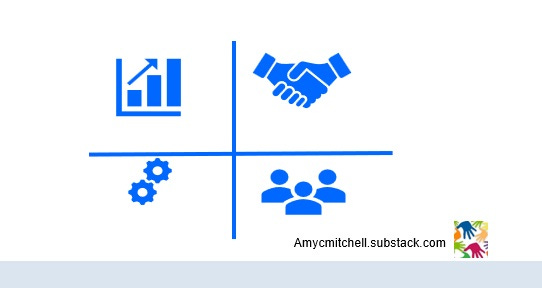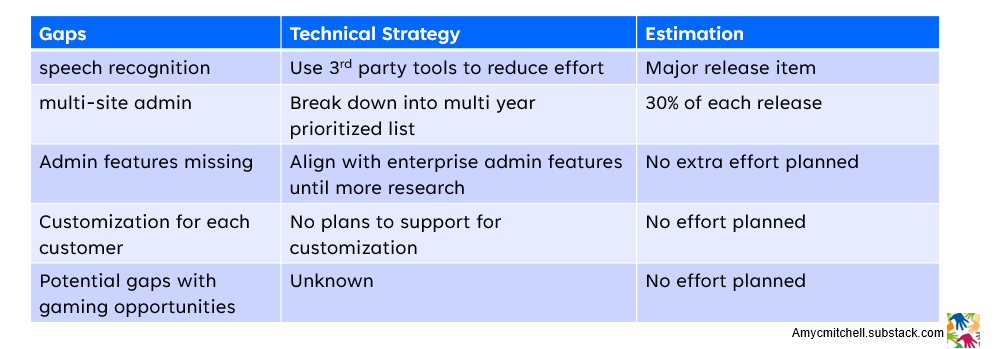Capturing the Next Customer Segment
How product managers select the next customer segment for expansion
Were you looking for more information about expanding to a new customer segment? After last week's article on Early Adopter to Product Growth, product people asked about selecting the next customer expansion.
As you transition from early adopter customers to product growth, a structured approach to pursue the next customer segment is helpful. Timing is critical - evaluate the options and decide about the next customer segment without losing momentum.
Let's dive into the steps to set the direction to select the next customer segment:
Estimate the growth rate of the segment
Confirm sales has relationships with the potential customers
Estimate the amount of product change required with engineering
Collaborate on a few possibilities and finalize the expansion strategy
These steps have the added benefit of focusing the product team on a new customer segment together.
Why Do a Structured Approach to Expansion?
There is already demand for the product. Why spend time evaluating additional segments? Isn't it better to get on with product marketing and sales support?
Please don't fall into the trap of simply amplifying what you did for the early adopters!
The early adopter customers have taught your organization about the strengths and weaknesses of your product and your fit in the market. Use this new knowledge to focus the whole product team.
Your product team is itching to grow their skills independently and without restrictions. This is the time to set direction and let the product team run with the customers.
Let’s look at an example of a structured approach in a case study.
Case Study of a Structured Approach to Expansion
A voice services product has two early adopter customers - high-growth enterprise businesses with call centers. The sales pipeline consists of:
Growing enterprises
Service providers
Gaming companies
The early adopter customers are happy with the product. The product team is ready to broaden the customer base.
The product managers take these steps.
Step 1: Estimate Growth Rates
A quick check using AI tools shows the following:
Enterprise VOIP growing 12% to $150B
Speech and voice recognition growing 19% to $16B with accelerating demand in 5-10 years
The communication services market is growing by 1.43% to $357B
Gaming services are growing 9% reaching $272B this year
The product managers examine the data and compare it to the segments of interest:
Growing enterprises:
12% growth - $150B market
The voice recognition market is accelerating
Service providers:
1.43% growth - $357B market
Includes mobile data
Gaming companies
9% growth - $272B market
Voice services in gaming aren't measured
The market growth rate exercise is time-boxed. Time to move to the next step.
Step 2: Collaborate on Sales Relationships
The product managers contact sales leaders about the potential segments. Using the CRM system, the product managers group the potential customers into interest segments. The goal of interviewing the sales leaders is to determine the types of relationships the sales teams have with potential customers.
A few questions for the sales leaders for each segment are:
Do the account teams have a background in the segment?
Did customer X come from a sales relationship or through another path?
How much do the account teams know about budget cycles in the segment?
Do the account teams know the buyers and the users in the segment?
The product managers get feedback from the sales leaders. They organize the feedback by segment:
Growing enterprise
Account teams have a long history with medium and large enterprises
The early adopter customers resulted from these relationships
Account teams know the rough budget and the buyers/users in enterprises using voice services
Service providers
A small percent of the account teams know the service provider market
The sales cycle is long and depends on the account team relationships
No customers in this segment so far
Gaming companies
No sales relationships
Opportunities in the CRM came from the technical team
The exercise on the sales relationships with potential customers concludes. Time to move to the next step
Step 3: Estimate the Amount of Product Change Needed
The next step is first done as a product manager and architect exercise. This is not a formal estimate of features! This is a quick gap analysis of the product to the segment.
First outline the possible gaps for each segment:
Growing enterprise
No speech recognition features
Limited administration across multiple sites
Service providers
Administrative features are missing
More customization for each customer
Gaming companies
Limited knowledge about any gaps
Then explore with technical leadership the rough impact of the gaps. Here is a summary of the gap estimation:
Now the product managers have a view of the growth potential, the sales abilities, and gap estimates for each segment under consideration. They can now collaborate and finalize their expansion strategy.
Step 4: Collaborate and Recommend
The product managers notice the following:
Each customer segment has growth opportunity
Most of the sales teams are aligned with the early adopter segment
Two segments have very high potential for the product
Technical strategy to support growth in the early adopter segment
The product managers recommend this approach to expand:
Expand in Segment 1 - Growing Enterprise
Add features to address the gaps
Support Segment 2 - Service Providers with Enterprise Features
No customization and no features for this segment
No marketing and limited sales support
Monitor Segment 3 - Gaming companies
Part-time product manager to define strategy
No marketing and sales enablement until a strategy is defined
With this recommendation, the product managers get agreement on the expansion strategy with stakeholders and the product team.
Conclusion - Ready for Broader Usage
Scaling your product from early adopters to a new customer segment is an exciting phase in the product lifecycle. The whole organization must buy into the expansion strategy. Taking these steps with time limits on the analysis gets the whole team aligned on the expansion:
Evaluate the segment's growth potential
—> Today and in the future
Leverage sales relationships
—> Strong connections with potential customers
Assess product needs
—> Estimate the impacts of the gaps
Collaborate and strategize
—> Finalize the expansion strategy
These steps focus the efforts on the expansion while setting triggers to monitor new developments.
Want to know what happened after a recent article? Premium subscribers get a peak behind the scenes of a recent newsletter. Last week’s backstory was what I missed in handling early adopter customers. Surviving Early Adopter Customers
Connect to Amy on LinkedIn, Threads, Instagram and X/Twitter









